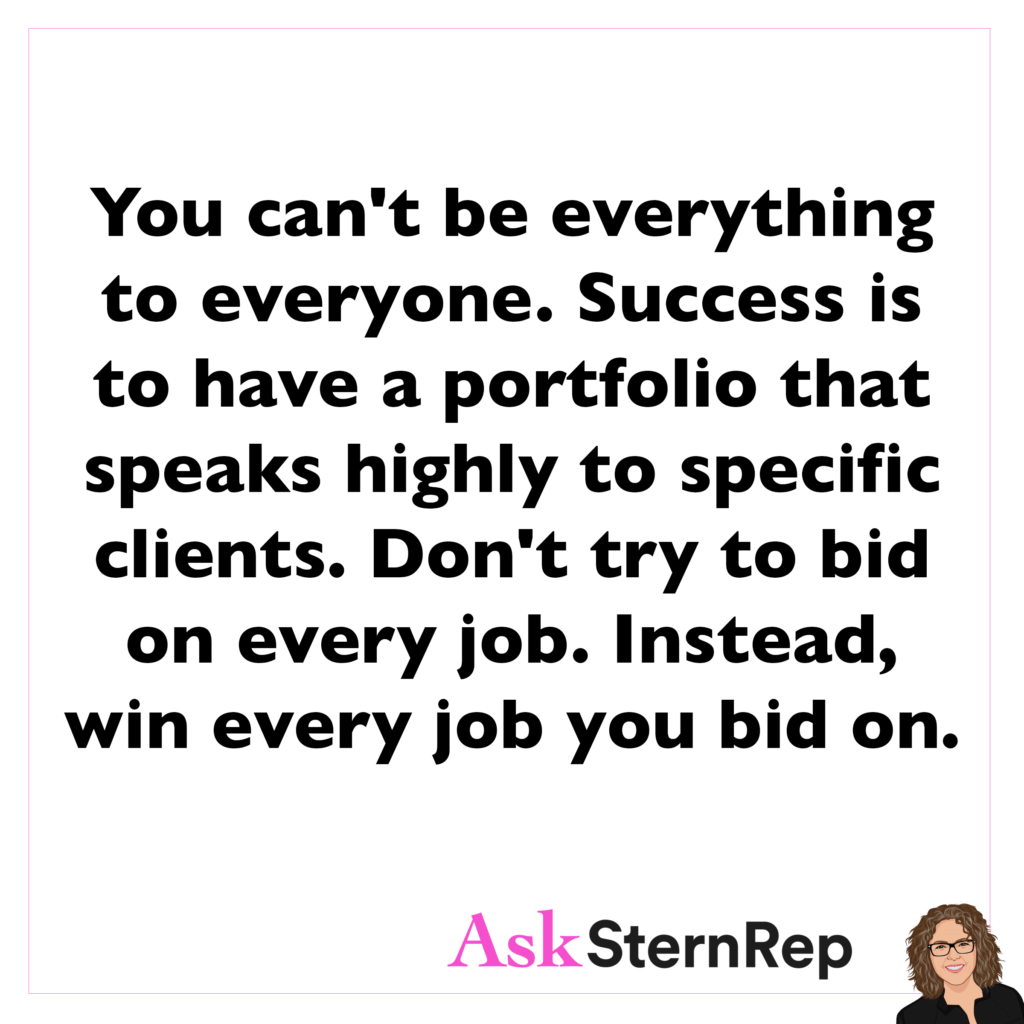
You can’t be everything to everyone. Success is to have a portfolio that speaks highly to specific clients. Don’t try to bid on every job. Instead, win every job you bid on.

You can’t be everything to everyone. Success is to have a portfolio that speaks highly to specific clients. Don’t try to bid on every job. Instead, win every job you bid on.
The #1 way to stay in front of clients is free and available at our fingertips, and yet we tend to ignore half of what we need to do- ENGAGEMENT. Sorry, I know it’s time-consuming, but why spend time and money on other marketing resources and ignore the one tool most guaranteed to work? Be your-human-self with comments and views, actively connecting as a real person.
If I were asked what the most important tip for a photographer is, I’d say something you might not want to hear. You hear us, Ranee and me, talk about this all the time on AskSternRep and SternRep: engagement on Instagram. Instagram—give me a minute, please. I know it’s the one place where we’re almost 90% sure clients are active. Where else are they actively engaging? Nowhere. Emails? LinkedIn, maybe? But on Instagram, they’re definitely there.
However, it’s not enough to just show our work. We have to engage with them so we show up in their stories and feed. We have to be the active ones—that’s the key. I know it might not be what you want to hear, but it’s really, really true. Please don’t hate me for saying it!
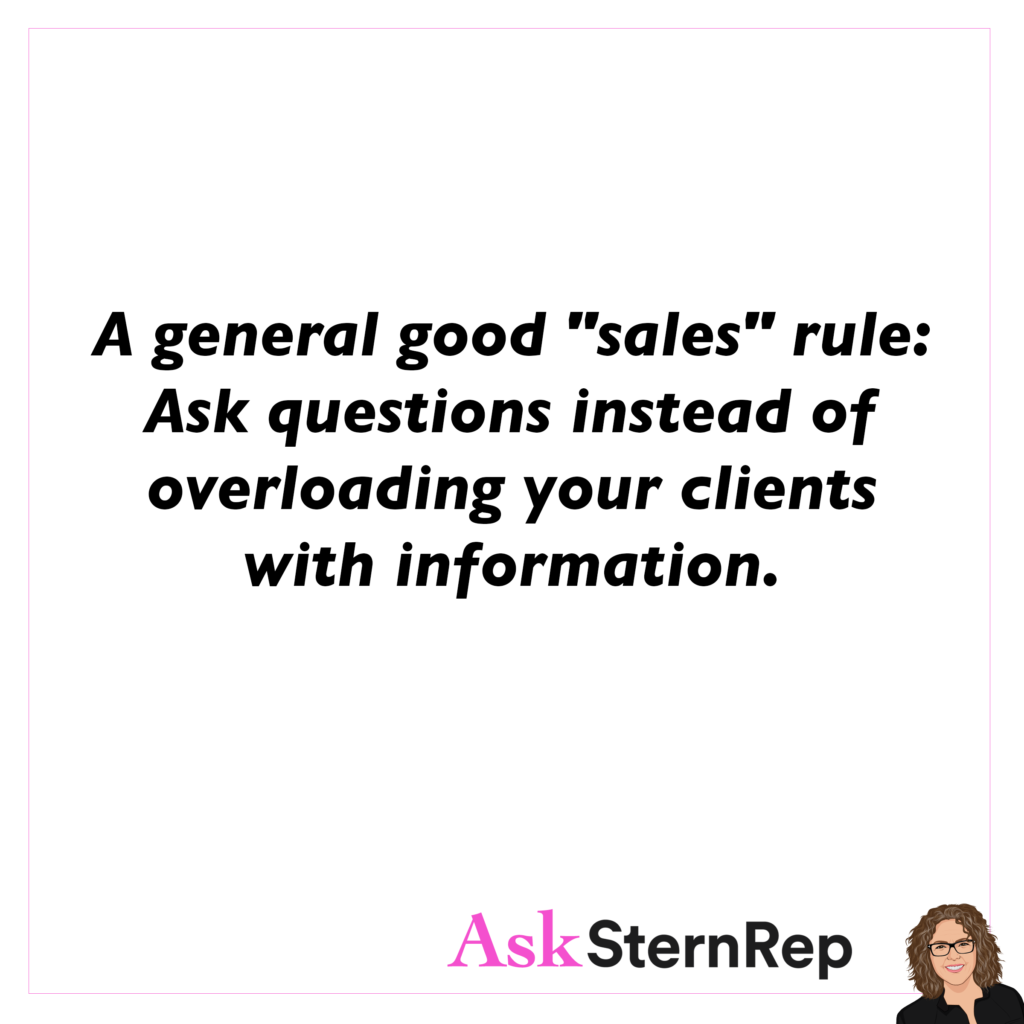
A general good “sales” rule: Ask questions instead of overloading your clients with information.
USAGE RENEWAL prices based on duration options are not split perfectly into divided values.
Two reasons:
1. We prefer the client to choose the more expensive, longer-term option.
2. Images may be more powerful, holding higher value when seen for a shorter time.
I deal with a lot of client requests regarding usage licensing rights, and they often want to know the price difference between various durations. It’s important to understand that the cost for different durations isn’t simply a matter of dividing a longer period by the number of shorter periods within it. For example, the cost for one month isn’t just one-twelfth of the cost for a year.
The impact of using an image for a shorter period, such as one month, can sometimes be greater, so we need to raise the value for shorter periods of time. It doesn’t work to just evenly divide the cost over time, and clients might not realize this. They might expect the price for a shorter duration to fit into the longer duration’s price equally divided, but that’s not the case. It’s important to know this and price your services fairly.
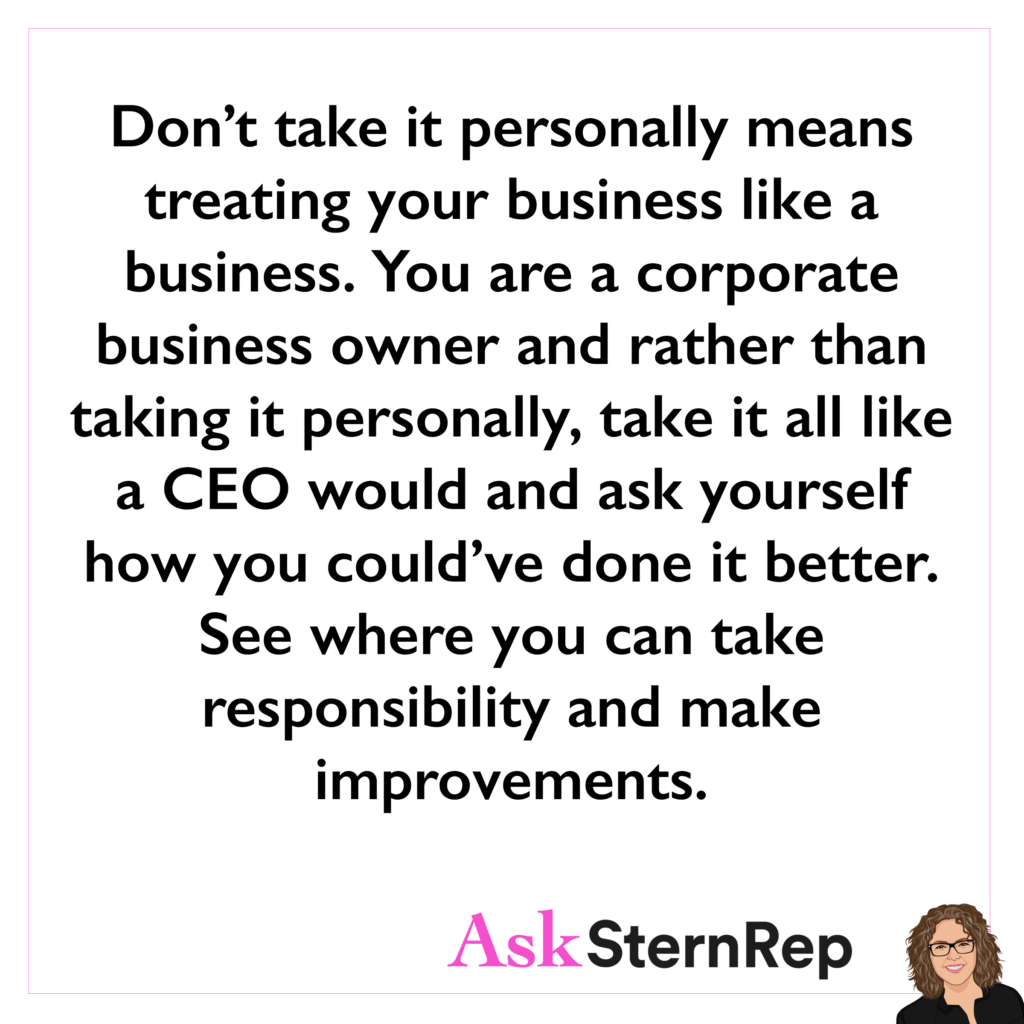
Don’t take it personally means treating your business like a business. You are a corporate business owner and rather than taking it personally, take it all like a CEO would and ask yourself how you could’ve done it better. See where you can take responsibility and make improvements.
Facing A Fact: Our 3rd party email promos are not getting through due to the client’s email filters.
Lessons to be learned:
-Even though this has been true for a while now, hearing it directly from a client makes it even more real.
-We cannot rely on email promos as our single source of marketing.
-We can use the ‘clicked on’ info as even more valuable to see who is seeing our work.
-Outdated promotion tactics have a place, but we have to stretch out and find less capacity ways to reach out.
I’ve been in denial about email promos actually landing in our clients’ inboxes. I received an email from a client, an art producer at a company, and this is what she said: “I think they’re more likely to open an email from me, as third parties have some tough email filters to get through and land in an inbox.” Of course, we all know this, but I haven’t really been facing the reality. I send out a lot of emails and spend money on them, but the promos might not be getting through as often as I thought.
I still think they’re worth doing, but they’re not landing as much as they should because of these companies’ email filters. One solution is to ask my contacts to send out the promos themselves. Another approach could be to use Instagram DMs or to engage with clients we’re already connected with on LinkedIn, perhaps posting or sending promos there. We need to find other ways to get our images seen by people who might not know us yet. I have to accept this and figure out alternative methods to reach our audience.
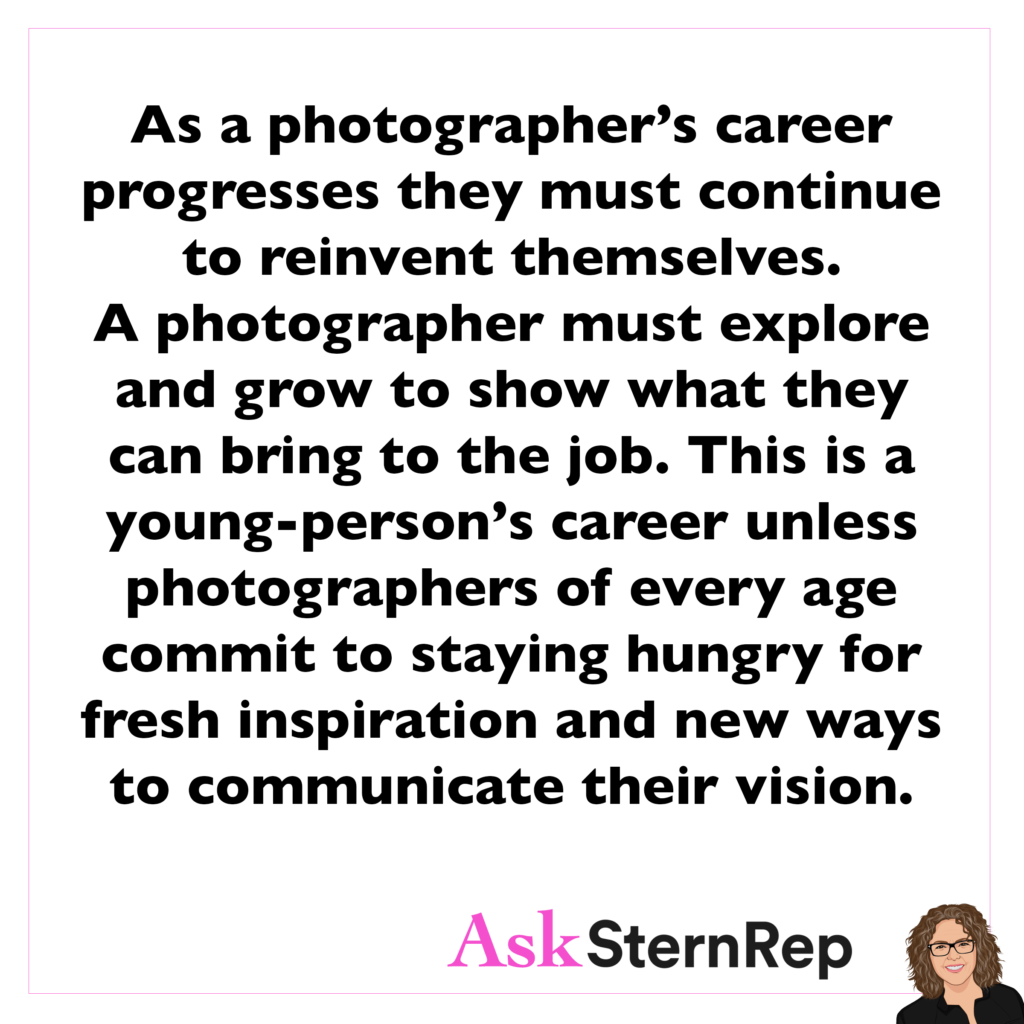
As a photographer’s career progresses they must continue to reinvent themselves. A photographer must explore and grow to show what they can bring to the job. This is a young-person’s career unless photographers of every age commit to staying hungry for fresh inspiration and new ways to communicate their vision.
As business owners, we must get our Marketing Plan in place to direct all the potential areas we should spend our time and budget on. Know all available options for crystal clear analysis of what is working, what to try, and what needs our attention. You are a business, so have a plan.
https://asksternrep.com/download-pdf-files-for-market-strategies/
We hear a lot about marketing budgets, and yes, they’re important, but even more crucial is having a marketing plan. That plan needs to adapt, shift, and constantly change with the times. The one constant truth about our business is that it’s always evolving, so we have to stay on top of that. I suggest checking in with your marketing efforts about four times a year or so.
Look at what you’re learning from your Google Analytics, SEO, and methods for getting email promos out there—it’s really challenging. Consider the effectiveness of sites like LinkedIn and Instagram, and whether you’re engaging and connecting with people. All of these aspects are part of your marketing plan.
Also, know what you are best at. Is it presenting to clients one-on-one in person, or is it sending them a printed portfolio? Whatever your strength is, master it, and then make sure to analyze and refine all the other parts of your marketing plan. Stay proactive and keep evolving your strategies.
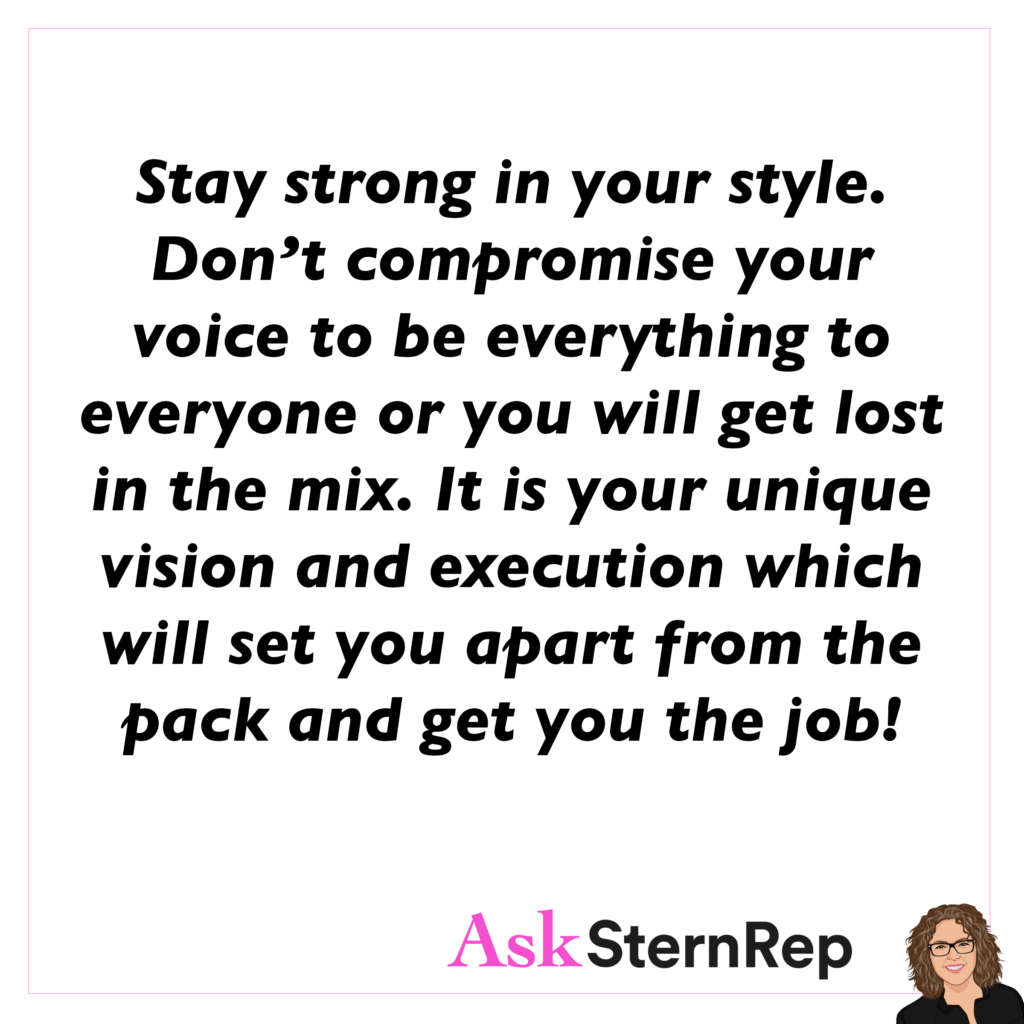
Stay strong in your style. Don’t compromise your voice to be everything to everyone or you will get lost in the mix. It is your unique vision and execution which will set you apart from the pack and get you the job!
What is the trick to Marketing? Quick answer: Relationships.
How to do this: Try everything, see what sticks, but only base some of your future marketing on what you learned in the past. I know this is tricky; we must try it all, keep experimenting, and DO NOT LIMIT OURSELVES only to what has worked in the past.
We all know how important marketing is in our business—it’s everything. Yet, there is no set plan for it; there is no absolute, definite “this must happen.” Of course, your website needs to be correct and up-to-date, but marketing as a whole has to be more experimental. I see it as throwing spaghetti against a wall and seeing what sticks. However, we can’t rely on just one approach over time; we have to continuously try new things.
Marketing is heavily based on relationships. I often get calls from clients I didn’t even know would remember my name, but we had a nice connection a year ago or even three years ago. When you get yourself on a list, clients remember you and want to stay in touch. The more we put ourselves out there, the better. We need to try everything, see what sticks, and not solely rely on what’s worked before. Do more of what works, but also explore every possible avenue to connect with clients.